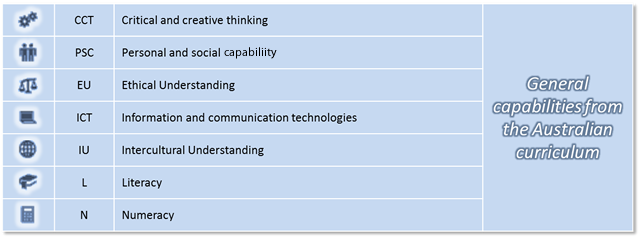New curriculum
How the new curriculum will meet the needs of learners
Development process
Click play for an explanation of the development process for the new curriculum.
Text version (.pdf 230kB)
The new curriculum in NSW is developed by the Board of Studies NSW and has been shaped by both the Australian Curriculum and the NSW context.
|
|
The Australian Curriculum has been developed by the Australian Curriculum, Assessment and Reporting Authority (ACARA) and guided by the 2008 Melbourne Declaration on Educational Goals for Young Australians. |
|
|
The NSW context includes consideration of the Education Act 1990, the Board of Studies NSW K-10 Curriculum Framework (.pdf) and Statement of Equity principles. |
Click play for an overview of the implementation timeline the new curriculum.
Text version (.pdf 247kB)
Learning areas
|
The deep knowledge and skills developed in each key learning area or subject provide the foundation for complex problem-solving and innovation. Learning areas and subjects provide students with a disciplined way of thinking or a lens for:
|
|
The aims and rationale of each new syllabus explain the particular learning purpose for each learning area.
|
Learning Area |
Aim and rationale summary |
Source |
|
English |
English is the study and use of the English language in its various textual forms … through which meaning is shaped, conveyed, interpreted and reflected. |
|
|
Mathematics |
Mathematics is a reasoning and creative activity employing abstraction and generalisation to identify, describe and apply patterns and relationships. |
|
|
Science and Technology K-6 and Science 7-10 |
Science inquiry is a distinct way of finding answers to interesting questions and important problems about the natural world locally, nationally and globally. |
|
|
History |
History equips students to develop a critical understanding of the past and its impact on the present. The study of history supports students to participate as informed, active and responsible citizens. |
Learning across the curriculum
|
The statements below are taken from The Shape of the Australian Curriculum (V3) (.pdf) (ACARA). |
|
|
|
|
Rather than being self-contained or fixed, disciplines are interconnected, dynamic and growing. A discipline-based curriculum should allow for cross-disciplinary learning. (point 57) |
|
|
|
Increasingly, in a world where knowledge itself is constantly growing and evolving, students need to develop a set of knowledge skills, behaviours and dispositions, or general capabilities that apply across subject-based content and equip them to be lifelong learners able to operate with confidence in a complex, information-rich, globalised world. (point 60)
|
|
The new syllabuses incorporate up to 13 areas in Learning across the curriculum. There are two main types:



|
|
Consider a complex issue such as climate change, poverty or bullying. Complete this interactive PDF (.pdf 157kB). |
Indicative time: 20 minutes
What is this tab about?
This tab explores how the new curriculum meets the needs of today’s learners and outlines how the new BOS NSW syllabuses were developed. It identifies the Learning across the curriculum areas and explains, through a series of videos, how these areas are interwoven through the key learning areas.
Delivery
-
Watch and listen to the animation about the development process for the new curriculum.
-
Click on the arrow and watch the animation about the implementation timeline.
-
Read the information about the learning areas and watch the video.
-
Click on the drop down box to briefly view the aims and rationale of each new syllabus. As an extension you may choose to explore these in more detail. Groups can click on a syllabus which is most relevant to them and report back to the group as a whole.
-
Read the statements by ACARA in the “Learning across the Curriculum” tab and watch the video.
-
Click on the drop-down tabs to show participants the 13 areas in Learning across the curriculum.
Completing activity 1: Learning across the curriculum
-
Participants consider a complex issue such as climate change, poverty or bullying, or another issue relevant to your school. While this may be done individually, the discussion will be richer as a collaborative activity.
-
Participants write a short statement about how up to three areas of their choice helps learners understand the issue chosen.
-
Participants write a short statement about how up to three areas of Learning across the curriculum help learners understand the issue chosen.




